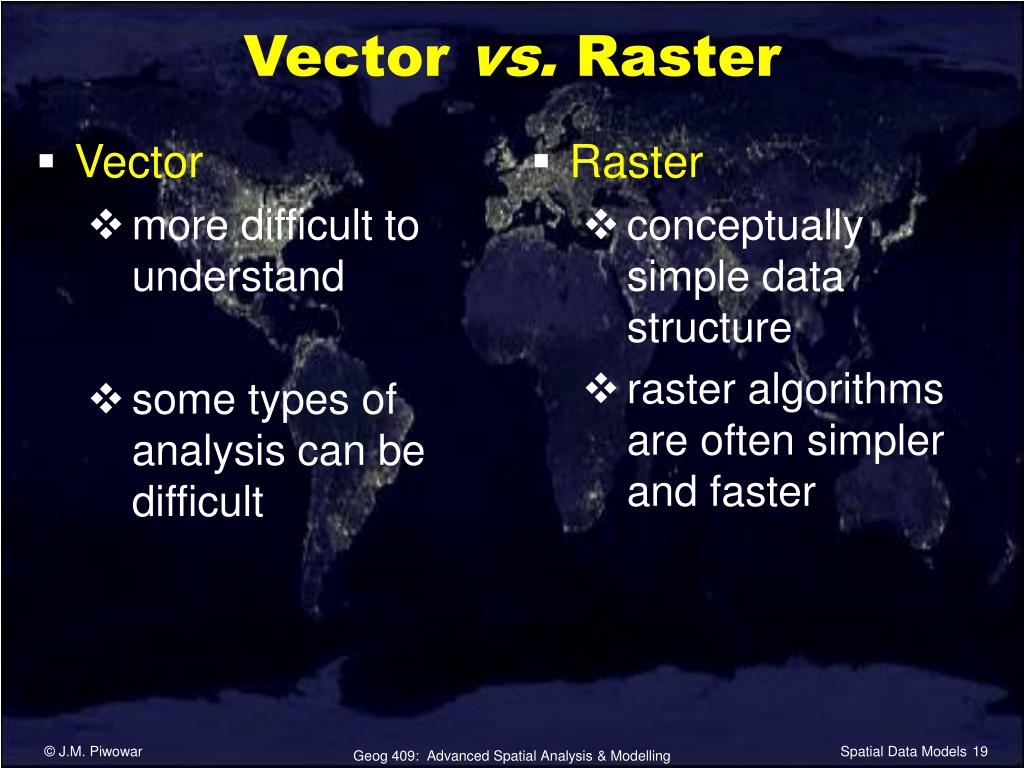

Raster images are often called bitmap images because they are made of millions of tiny squares, called pixels.
#Raster versus vector data software
Be aware though, that if you create add type to an image or another type of file in software such as Adobe Photoshop (which is raster-based), your text will lose its vector attributes once the image is flattened and saved. This also keeps type from looking blocky and helps certain typefaces maintain their smooth shapes and edging. Type and fonts are also created as vector images, which allows you to change the size while maintaining quality. You will get more flexibility and more for your money when you buy vector-based clip art rather than high-DPI images. High-resolution, high-quality clip art is often developed and sold as vector images as well. Keeping a nice library of vector images can save you time because of the ability to resize on the fly. These files are saved and are used as the basis for raster copies that get used in print and web publishing. Most companies create all of their logos and insignia as vector images. Only illustrations that are made to look like photographs can be created in a vector workspace. You may only need a web logo now, but image how great it would be to have that image ready to use on a banner or merchandise later without having to create it all over again? Photos Because of the way images are created and saved, you will have more flexibility with making changes and be able to use your image at a variety of sizes. 1 option when designing or creating a logo or illustration.

Vector images are often saved as native files from the program used to create the image, such as Adobe Illustrator, which may not be available to everyone you need to work with (though widely compatible formats do exist). The most common problem with using vector images is compatibility. Vector images, therefore, are often easy to transmit from one computer to another and over the Internet. Because the files are only identified by mathematical descriptions and not individual pixels, files are often much smaller than those of the raster counterparts. No matter how much you increase a font’s size, for example, its look never changes.Īnother advantage to using vector images is file-size efficiency. Text is one of the most common types of vector image. You can identify a vector image by looking at its edges - a vector image will always appear smooth no matter how large you make it or how close you zoom in. Because of this defined, formulaic approach to drawing, each image can be sized and scaled repeatedly and limitlessly without losing resolution or beginning to look cloudy or pixelated. Any of the lines and curves in the image can be assigned a color value. Vector graphics must be created in computer software that is designed to create this intricate wireframe-type image and each line includes defined node positions, node locations, line lengths and curves. Vector images, which are made of thin lines and curves known as paths, are rooted in mathematical theory. This process is experimental and the keywords may be updated as the learning algorithm improves.Vector images, which are made of thin lines and curves known as paths, are rooted in mathematical theory. These keywords were added by machine and not by the authors. For example, a road can be represented as a combination of lines. Vector data involves storing data as geometric objects. There are two major ways to model spatial data: as vector data or as raster data. Both models of the data must have the property of storing locations, features and the association between the two. It is necessary to convert spatial data into a form that a computer can understand. For example, it may be useful to represent both the population and the average age group of a city. Note that a location may have one or more features. In the second example, the region is a collection of locations and the type of soil is the feature. In the first example, the city could be considered as a location and the population is the data or a feature.

Some examples include the population of a city, the type of soil in a region, and data from remote‐sensing satellites. Spatial data is data related to a location.


 0 kommentar(er)
0 kommentar(er)
